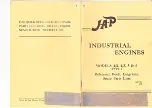
Compressed air
• Unauthorized use of compressed air, e.g. forcing flammable liquids (hazard class AI, AII and B) out of con-
tainers, risks causing an explosion.
• Wear goggles when blowing off components or blowing away chips.
• Blowing compressed air into thin-walled containers (e.g. containers made of sheet metal, plastic or glass)
for drying purposes or to check for leaks risks bursting them.
• Pay special attention to the pressure level in the compressed air network or pressure vessel.
• Assemblies or products which are to be connected must be designed to withstand this pressure. Install
pressure-reducing or safety valves set to the admissible pressure if this is not the case.
• Hose couplings and connections must be securely attached.
• Provide the snout of the air nozzle with a protective disk (e.g. rubber disk).
• Relieve residual pressure before removing compressed-air equipment from the supply line. To depressu-
rize compressed-air lines, shut off the lines first, then release the residual pressure.
• Perform leak testing in accordance with instructions.
Paints and lacquers
• Observe the relevant safety data sheet for all materials.
• When carrying out painting work outside the spray stands provided with fume extraction systems, ensure
that the area is well ventilated. Make sure that neighboring work areas are not impaired.
• Avoid open flames in the vicinity.
• No smoking.
• Observe fire prevention regulations.
• Always wear a mask providing protection against paint and solvent vapors.
Liquid nitrogen
• Observe the relevant safety data sheet for all materials.
• Work with liquid nitrogen may be carried out only by qualified personnel.
• Store liquid nitrogen only in small quantities and always in regulation containers without fixed covers.
• Avoid body contact (eyes, hands).
• Wear protective clothing, protective gloves, closed shoes and protective goggles / safety mask.
• Make sure that the working area is well ventilated.
• Avoid all knocks and jars to the containers, fixtures or workpieces.
Acids/alkaline solutions/urea (AdBlue
®
, DEF)
• Observe the relevant safety data sheet for all materials.
• When working with acids and alkaline solutions, wear protective goggles or face mask, gloves and protec-
tive clothing.
• Do not inhale vapors.
• If urea solution is swallowed, rinse out mouth and drink plenty of water.
• Remove any wet clothing immediately.
• Wash affected body areas with plenty of water after skin contact.
• Rinse eyes immediately with eyedrops or clean tap water after eye contact. Seek medical attention as
soon as possible.
18 | Safety | MS150098/02E 2016-11
TIM-ID: 0000040536 - 012
















































